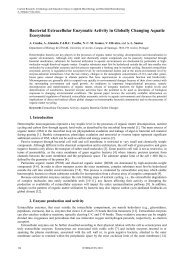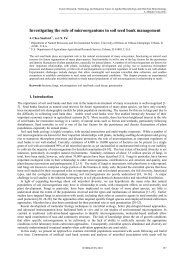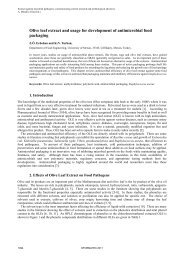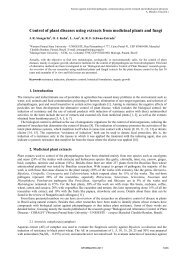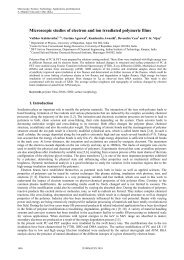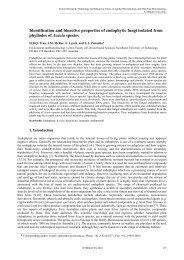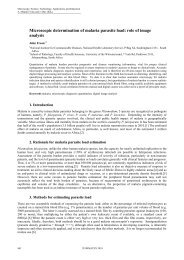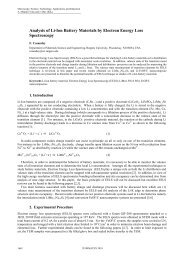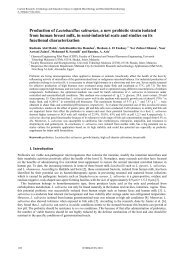Scanning electron microscopy of plant surfaces - Formatex ...
Scanning electron microscopy of plant surfaces - Formatex ...
Scanning electron microscopy of plant surfaces - Formatex ...
Create successful ePaper yourself
Turn your PDF publications into a flip-book with our unique Google optimized e-Paper software.
Microscopy: Science, Technology, Applications and Education<br />
A. ______________________________________________<br />
Méndez-Vilas and J. Díaz (Eds.)<br />
<strong>Scanning</strong> <strong>electron</strong> <strong>microscopy</strong> <strong>of</strong> <strong>plant</strong> <strong>surfaces</strong>: simple but sophisticated<br />
methods for preparation and examination<br />
H. J. Ensikat, P. Ditsche-Kuru and W. Barthlott<br />
Nees Institute for Biodiversity <strong>of</strong> Plants, University <strong>of</strong> Bonn, Meckenheimer Allee 170, 53115 Bonn, Germany<br />
A repertory <strong>of</strong> tailored preparation techniques for scanning <strong>electron</strong> <strong>microscopy</strong> (SEM) <strong>of</strong> <strong>plant</strong> <strong>surfaces</strong> is introduced in<br />
this report. Biological specimens for conventional SEM are usually dehydrated by suitable drying methods and coated with<br />
a thin metal layer to achieve a sufficient electrical conductivity. But many parts <strong>of</strong> <strong>plant</strong>s, such as leaves and fruits, are<br />
covered with a cuticle which provides good mechanical strength and low permeability for water. The robustness and the<br />
low water evaporation rate allow to examine <strong>plant</strong> samples without drying or to apply simple cryo-procedures which are<br />
not suitable for other s<strong>of</strong>t biological samples. Some <strong>of</strong> these methods have been tested in the early times <strong>of</strong> SEM but seem<br />
to be almost forgotten. Here we describe advancements <strong>of</strong> these techniques making an easy application possible. This<br />
broadens the repertory <strong>of</strong> practical methods for the examination <strong>of</strong> <strong>plant</strong> tissues in a conventional SEM under high vacuum<br />
conditions without the need for expensive special equipment (such as Environmental SEM or cryo stages). In this article,<br />
we present the advantages and limitations <strong>of</strong> these additional methods, which can be used to avoid the artefacts <strong>of</strong> the<br />
commonly used preparation techniques, such as the influence <strong>of</strong> organic solvents or shrinkage. Many undried <strong>plant</strong><br />
samples can be examined successfully in a ‘fresh hydrated’ state, due to the low water permeability <strong>of</strong> the cuticle. Fresh<br />
and glycerol-infiltrated samples have a sufficient internal electrical conductivity that they can be examined without metal<br />
coating. Several preparation techniques are presented which keep the sample surface untapped, without immersion in<br />
liquids. This is particularly interesting for the study <strong>of</strong> fragile epicuticular waxes or contaminations on superhydrophobic<br />
‘self-cleaning’ <strong>surfaces</strong> (‘Lotus effect’) and air-retaining <strong>surfaces</strong> (‘Salvinia effect’, [1]). These methods include simplified<br />
cryo-preparations for low-temperature-SEM and freeze drying. Applications <strong>of</strong> the methods include ‘material-contrast<br />
imaging’ <strong>of</strong> uncoated samples using the backscattered <strong>electron</strong> (BSE) signal or the study <strong>of</strong> interactions between liquids<br />
and <strong>plant</strong> <strong>surfaces</strong> by low-temperature SEM. Suggestions for the examination <strong>of</strong> non-conductive samples complete the<br />
instructions.<br />
Keywords <strong>Scanning</strong> <strong>electron</strong> <strong>microscopy</strong>; <strong>plant</strong> <strong>surfaces</strong>; cryo-preparation; slow freezing; low-temperature SEM; freeze<br />
drying; glycerol substitution; fresh-hydrated samples; epicuticular waxes<br />
1. Introduction<br />
For conventional scanning <strong>electron</strong> <strong>microscopy</strong> (SEM), that means in high vacuum and at ambient temperature, it is a<br />
widely accepted principle that biological samples must be dehydrated and need a conductive coating. Therefore several<br />
drying techniques, which avoid or reduce tissue shrinking, such as Critical point drying [2] or Freeze drying, have been<br />
developed [3]. Mechanically stable samples may be dried simply at the air. In the early days <strong>of</strong> scanning <strong>electron</strong><br />
<strong>microscopy</strong> several SEM-pioneers tested various methods and the limitations <strong>of</strong> the new <strong>microscopy</strong> [4-6]. For <strong>plant</strong><br />
samples, alternatives to the drying methods were tested with varying success. Undried, fresh-hydrated samples without<br />
metal coating could be observed without strong charging effects, but some rapidly desiccating samples allowed only<br />
short observation times and low magnification [7, 6]. Further alternatives, which were developed early, were the<br />
imaging <strong>of</strong> glycerol-infiltrated samples [8, 9] and replication techniques [10, 11]. In the meantime, many <strong>of</strong> the<br />
experiences <strong>of</strong> the pioneers seem to be forgotten widely and only few preparation methods for <strong>plant</strong>s are used routinely<br />
[12, 13]. Only sporadicly, publications present the successful use <strong>of</strong> simplified methods for the examination <strong>of</strong> <strong>plant</strong><br />
<strong>surfaces</strong>. Craig and Beaton [14] successfully used slow cooling for Low-Temperature-SEM. The feasibility to examine<br />
<strong>plant</strong> <strong>surfaces</strong> without metal coating was shown for fresh-hydrated samples [15, 16] and glycerol-infiltrated samples<br />
[17]. Meanwhile, the focus <strong>of</strong> the SEM techniques turned towards the development <strong>of</strong> sophisticated special equipment:<br />
Low-temperature sample stages with integrated sputter coaters have been developed for the imaging <strong>of</strong> frozen-hydrated<br />
samples [18, 19]. The “Environmental <strong>Scanning</strong> Electron Microscope” (ESEM), which tolerates liquid water in the<br />
specimen chamber, is useful to view fresh-hydrated samples at ambient temperature, and it can image non-conductive<br />
samples without disturbing electric chargings [20, 21]. However, these equipments are quite expensive, and many<br />
biologists do have only the standard equipment.<br />
During the examination <strong>of</strong> numerous <strong>plant</strong> samples we found that unusual preparation methods <strong>of</strong>ten gave superior<br />
results for conventional SEM. The robust and almost impermeable cuticle, which forms many <strong>plant</strong> <strong>surfaces</strong>, allows the<br />
use <strong>of</strong> some techniques which are not suitable for s<strong>of</strong>t wet biological material.<br />
Experiments with glycerol-infiltrated samples and with fresh-hydrated <strong>plant</strong> material had shown that the internal<br />
liquids provide a sufficient electrical conductivity to avoid charging problems in the SEM, so that the samples can be<br />
examined without metal coating [17, 22]. The various tasks in the study <strong>of</strong> <strong>plant</strong> <strong>surfaces</strong> (Lotus effect, epicuticular<br />
waxes, contaminations, droplet-surface interactions) need such a repertory <strong>of</strong> methods which include the observation <strong>of</strong><br />
untouched and uncoated samples either at ambient temperature or in a frozen state. Our experiences may help other<br />
248 ©FORMATEX 2010
microscopists to become acquainted with simple cryo-preparation methods and to choose the optimal techniques for<br />
their sample preparation.<br />
2. Material and Methods<br />
2.1 Plant material<br />
Leaves <strong>of</strong> 7 <strong>plant</strong> species are presented in this study. The <strong>plant</strong>s were cultivated in the Botanical Gardens, University <strong>of</strong><br />
Bonn (BG Bonn): Nelumbo nucifera (Lotus), Tropaeolum majus (Garden nasturtium), Urtica dioides (Stinging-nettle),<br />
Drosera nidiformis, Salvinia molesta, Salvinia oblongifolia, Ruellia devosiana.<br />
2.2 Equipment<br />
A Cambridge Stereoscan S200 SEM (Cambridge, UK) equipped with a secondary <strong>electron</strong> (SE) detector and a<br />
backscattered <strong>electron</strong> (BSE) detector (scintillator type) was used at acceleration voltages between 10 and 20 kV.<br />
Images were recorded with an integrated digital image acquisition system (DISS5, Point Electronic, Germany). A<br />
home-made cooling holder was used for low-temperature examinations.<br />
Critical point drying (CP-drying) was made with a Balzers CPD 020 CP-dryer (Bal Tec AG, Liechtenstein).<br />
Metal coating with gold or gold/palladium was performed with a Balzers SCD 040 sputter coater (Bal Tec AG).<br />
2.3 Preparation methods<br />
Microscopy: Science, Technology, Applications and Education<br />
______________________________________________<br />
A. Méndez-Vilas and J. Díaz (Eds.)<br />
CP-drying: Samples were fixated in formaldehyde solution (2% formaldehyde, 70% ethanol, 5% acetic acid),<br />
dehydrated with ethanol (80%, 90%, 99%) and CP-dried with CO2.<br />
Air-drying: Fresh leaves were mounted on SEM stubs and stored in a desiccator with silica gel until dry.<br />
Fresh-hydrated material: Pieces <strong>of</strong> 3 to 10 mm size were cut out <strong>of</strong> the leaves. The cut faces were sealed with glue<br />
(conductive carbon glue or two-component epoxy glue). The pieces were mounted on SEM stubs with a conductive<br />
adhesive tab. The undried samples were examined with or without metal coating. For samples, which run dry rapidly,<br />
only one piece was mounted on the SEM stub, and the SEM sample holder was cooled with ice close to 0°C prior to<br />
insertion into the SEM in order to slow down the desiccation.<br />
Glycerol substitution: The procedure “infiltration from below” was used, which keeps the surface <strong>of</strong> hydrophobic<br />
samples dry and untouched [23]. Leaf pieces <strong>of</strong> 3 to 10 mm size were excised, then the epidermis <strong>of</strong> the underside <strong>of</strong><br />
the sample was scratched with coarse abrasive paper in order to enable the permeation <strong>of</strong> the preparation liquids. In a<br />
petri dish, a piece <strong>of</strong> fabric was soaked with fixative (2% glutaraldehyde). Then the samples were placed on the fabric,<br />
so that they were infiltrated by the fixative for ca. 2 h. For the substitution <strong>of</strong> the water, the liquid soaking the fabric was<br />
exchanged with glycerol solutions with raising concentrations in 10% steps, or continuously, up to 90%, each step ca 2<br />
h. Then the samples were stored in a desiccator with silica gel for at least 24 h to remove remnants <strong>of</strong> water. The<br />
glycerol-infiltrated samples were mounted on SEM stubs with a conductive glue and examined with or without metal<br />
coating.<br />
Simple Cryo-preparations:<br />
Slow-cooling: The fresh samples were clamped in the cooling holder, which consists <strong>of</strong> a metal block with a sample<br />
chamber, a cover, and a thermal isolation (Fig. 1). Then the covered holder was placed in a container with liquid<br />
nitrogen (LN2) and cooled down without immersing the sample in LN2. The initial cooling rate was ca 2K/sec.<br />
(Diagram Fig. 1c). The cooled holder was inserted into the SEM for low-temperature examination or into another highvacuum<br />
chamber for freeze-drying.<br />
Low-temperature SEM (LT-SEM): After insertion <strong>of</strong> the cooling holder into the SEM and evacuation <strong>of</strong> the specimen<br />
chamber, the cover <strong>of</strong> the holder was removed and the sample was examined using very low beam intensities. Due to<br />
the thermal isolation, the temperature <strong>of</strong> the holder raises slowly (Diagram Fig. 1d). Thus the samples can be examined<br />
for hours at low temperatures.<br />
Freeze drying: The cooling holder with the frozen sample was simply left in the SEM or in another high-vacuum<br />
chamber overnight. Then it has reached room temperature. In the meantime, the tissue water has evaporated at<br />
temperatures far below 0°C. The dried samples were mounted on normal SEM stubs and sputter-coated.<br />
©FORMATEX 2010 249
Microscopy: Science, Technology, Applications and Education<br />
A. ______________________________________________<br />
Méndez-Vilas and J. Díaz (Eds.)<br />
Fig. 1 The self-made cooling holder (a: separate, b: mounted on the SEM stage and closed with a cover) was the only ‘special<br />
equipment’ for this study. (c): The cooling rate <strong>of</strong> the holder during ‘slow cooling’ with LN2. (d): The warm-up rate <strong>of</strong> the holder in<br />
the SEM during examination.<br />
3. Results and Discussion<br />
The cuticles, which cover many parts <strong>of</strong> terrestrial <strong>plant</strong>s, provide many <strong>of</strong> them with sufficient mechanical stability and<br />
resistance to desiccation, that the presented SEM-preparation methods <strong>of</strong>ten give superior results. Compared to the<br />
commonly used methods CP-drying and air-drying with their influence <strong>of</strong> organic solvents or massive shrinkage, these<br />
alternative procedures avoid such alterations. The example Lotus leaf (Nelumbo nucifera) is used to demonstrate the<br />
suitability and differences <strong>of</strong> these preparation methods (Fig. 2a-f). The advantages and limitations <strong>of</strong> the methods are<br />
described in the following paragraph and summarised in Table 1.<br />
CP-drying (Fig. 2a): The surface <strong>of</strong> the Lotus leaf shows a good preservation <strong>of</strong> the papillae, but the epicuticular waxes<br />
are completely destroyed. It is known that the wax type which occurs on Lotus leaves (secondary-alcohol tubules), is<br />
easily dissolved in ethanol during the dehydration procedure. Other wax types, such as platelets, on other species are<br />
less soluble and may be affected only slightly.<br />
Air-drying (Fig. 2b): The papillae <strong>of</strong> the Lotus leaf are collapsed, but high-magnification imaging <strong>of</strong> the wax tubules is<br />
possible.<br />
Fresh-hydrated material (Fig. 2c, 3a-c): When we tried to observe fresh leaves in a conventional SEM, we were<br />
surprised to find that the majority <strong>of</strong> samples could be examined for at least several minutes before desiccation artefacts<br />
could be noticed. The durability varied strongly. Many full-grown leaves <strong>of</strong> native trees and conifer needles resist the<br />
desiccation for hours. Most thin, still growing leaves <strong>of</strong> herbs (e.g. Tropaeolum majus, Urtica dioides, Taraxacum<br />
<strong>of</strong>ficinale leaves, Fig. 3) can be examined for several minutes up to an hour, sufficient to acquire some pictures.<br />
However, leaves with very thin cuticles, such as petals <strong>of</strong> flowers or leaves from species growing at humid habitats, dry<br />
out immediately in the SEM before the vacuum is ready. Sometimes, only certain cell types, such as glands or some<br />
trichomes, shrink, while normal epidermis cells remain turgescent and convex for a longer time. Examination <strong>of</strong> freshhydrated<br />
leaves has several advantages: the preparation is fast; the surface remains untouched; the internal electrical<br />
conductivity allows imaging without metal coating, which is particularly useful for material-contrast imaging using the<br />
BSE signal. The ‘atomic number contrast’ <strong>of</strong> the BSE images indicates e.g. the accumulation <strong>of</strong> Ca and Si in the hairs<br />
<strong>of</strong> stinging-nettles (Fig. 3b) or inorganic material in contaminations on leaves (Fig. 3c).<br />
250 ©FORMATEX 2010
Microscopy: Science, Technology, Applications and Education<br />
______________________________________________<br />
A. Méndez-Vilas and J. Díaz (Eds.)<br />
Fig. 2 Lotus leaf (Nelumbo nucifera) treated with 6 different preparation methods. (a): CP-drying preserves the papillae, but the<br />
epicuticular waxes are destroyed. (b): Air-drying causes severe shrinkage <strong>of</strong> the epidermal cells. (c): The fresh-hydrated sample<br />
(without metal coating) at ca 5°C shows little shrinkage after 10 minutes observation time. The waxes are intact, but sample drift<br />
retards high magnifications. (d): Glycerol-infiltration prevents shrinkage <strong>of</strong> the papillae; the waxes are intact, the surface is dry and<br />
untouched; sample without metal coating. (e): Low-temperature SEM image <strong>of</strong> the frozen-hydrated sample without metal coating.<br />
The waxes and papillae are intact, but the image contrast is poor due to charging <strong>of</strong> the non-conductive sample. (f): The freeze-dried<br />
sample with metal coating shows good preservation <strong>of</strong> the papillae and waxes and is suitable for high magnification (the inset shows<br />
the wax tubules).<br />
Fig. 3 Examples <strong>of</strong> fresh-hydrated leaves at ambient temperature in high vacuum. (a): Tropaeolum majus leaf with turgescent cells<br />
and the characteristic distribution <strong>of</strong> wax tubules, with metal coating. The high-magnification inset was acquired after the sample had<br />
dried. (b):Petiole (leaf stem) <strong>of</strong> Urtica dioides with stinging-hairs., without metal coating. The SE-image (top) shows the topography;<br />
the atomic-number contrast <strong>of</strong> the BSE-image indicates the accumulations <strong>of</strong> Si- and Ca-compounds as bright structures. (c): Leaf<br />
surface <strong>of</strong> Taraxacum <strong>of</strong>ficinale, without metal coating. The SE-image (top) shows the topography <strong>of</strong> the turgescent cells; the BSEimage<br />
indicates inorganic contaminations.<br />
Nevertheless the samples may be coated with metal to obtain a better contrast <strong>of</strong> fine details (e.g. epicuticular wax<br />
crystals, Fig. 3a, 2f) , if they resist the desiccation in the vacuum <strong>of</strong> the sputter coater for additional few minutes. A<br />
severe limitation in the examination <strong>of</strong> fresh-hydrated material is caused by a drift <strong>of</strong> the specimen due to continuing<br />
desiccation, which hinders high magnification imaging. (The high-magnification inset in Fig. 3a was recorded after the<br />
sample had dried.) Some measures are useful for preparation <strong>of</strong> rapidly drying samples such as the Lotus leave (Fig.<br />
2c): Only one small piece should be inserted into the SEM. The cut faces should be sealed with glue. Cooling the<br />
sample holder simply with ice decelerates the desiccation. For imaging without metal coating, the samples must be<br />
mounted with a conductive glue.<br />
©FORMATEX 2010 251
Microscopy: Science, Technology, Applications and Education<br />
A. ______________________________________________<br />
Méndez-Vilas and J. Díaz (Eds.)<br />
Glycerol substitution (Fig. 2d) is an alternative to drying methods and provides the samples with internal electrical<br />
conductivity, similar to fresh-hydrated material. Compared to using fresh samples, it allows much longer examination<br />
times and provides better stability for higher magnifications. Glycerol is a polar, water-miscible liquid with a very low<br />
vapour pressure, so that it can be used in the high vacuum <strong>of</strong> the SEM and can be imaged without problems.<br />
Hydrophobic <strong>plant</strong> <strong>surfaces</strong> are not wetted by glycerol during the preparation, thus they remain dry and untouched. The<br />
samples can be examined with or without metal coating, similar to fresh-hydrated ones. Limitations <strong>of</strong> the glycerol<br />
substitution are caused by insufficient infiltration <strong>of</strong> certain tissues, e.g. hairs; other samples like flowers become too<br />
s<strong>of</strong>t, so that they collapse. A disadvantage is the long preparation time, but multiple samples can be prepared<br />
simultaneously. A glycerol infiltration without previous fixation is possible and gives usually satisfying results. Thus<br />
the use <strong>of</strong> toxic chemicals can be avoided, which makes the method suitable e.g. for schools.<br />
Simple cryo-preparations:<br />
Slow cooling: Although the slow cooling <strong>of</strong> biological samples causes the formation <strong>of</strong> coarse ice crystals in the tissue,<br />
we never observed traces <strong>of</strong> them on the <strong>plant</strong> <strong>surfaces</strong>. Only some minor cracks appeared on some specimens (Fig. 4c,<br />
arrow). Thus it is not necessary to immerse the samples in a cooling liquid to achieve high cooling rates. Instead, the<br />
surface remains untouched during the preparation; only the sample holder is in contact with LN2. The frozen samples<br />
can then be used for LT-SEM and / or for freeze-drying.<br />
Fig. 4 Examples <strong>of</strong> LT-SEM images <strong>of</strong> uncoated samples after slow-cooling. (a, b): Drosera nidiformis. (c, d): Superhydrophobic<br />
trichomes <strong>of</strong> Salvinia molesta; a glycerol drop resting on the tips <strong>of</strong> the trichomes demonstrates the low wettability.<br />
LT-SEM (Fig. 2e, 4, 5a,c): Using a special thermally-isolated sample holder, the frozen samples can be examined after<br />
insertion into the SEM. At temperatures below -100°C, the frozen samples without metal coating are non-conductive,<br />
thus it is difficult and requires some experience to avoid imaging problems caused by electric charging. The main<br />
advantages <strong>of</strong> the examination <strong>of</strong> frozen-hydrated samples are the reliable prevention <strong>of</strong> desiccation or dehydration<br />
artefacts and the rapid preparation. The <strong>surfaces</strong> remain untouched and, without a metal coating, they are suitable for<br />
material contrast imaging with a BSE-detector. Examination at low magnifications is possible despite the poor<br />
conductivity (Fig. 2e, Fig. 4) . Charging effects on frozen-hydrated samples appear considerably slighter than on dry<br />
samples without metal coating. But at higher magnifications the charging problems increase and inhibit successful<br />
working. During insertion <strong>of</strong> the sample into the SEM, contact with air moisture should be avoided with a tight cover.<br />
If, however, ice crystals have grown on the sample, they will evaporate and disappear when the temperature <strong>of</strong> the<br />
252 ©FORMATEX 2010
Microscopy: Science, Technology, Applications and Education<br />
______________________________________________<br />
A. Méndez-Vilas and J. Díaz (Eds.)<br />
sample raises. Then, images <strong>of</strong> the clean <strong>surfaces</strong> can be obtained. Further, the conductivity <strong>of</strong> the sample increases<br />
with the temperature and reduces charging effects.<br />
Moderate cooling <strong>of</strong> the samples to temperatures between -80°C and -40°C combines the advantages <strong>of</strong> fresh-hydrated<br />
material and LT-SEM and avoids some difficulties. The cooling reduces the desiccation sufficiently, so that also<br />
flowers, petals and other delicate samples can be examined. In this temperature range, the internal conductivity is<br />
sufficient to avoid charging problems (Fig. 5a,c). These temperatures can be generated with peltier elements without the<br />
risk <strong>of</strong> freezing problems with the SEM specimen stage; only reliable heat dissipation is necessary.<br />
Fig. 5 Frozen-hydrated (a, c) and freeze-dried (b, d) samples <strong>of</strong> Salvinia oblongifolia (a, b) and Ruellia devosiana (c, d). The LT-<br />
SEM images at moderate cooling without metal coating show perfect preservation and no chargings. The freeze-dried S. oblongifolia<br />
is well preserved and stable for high magnification imaging <strong>of</strong> the waxes (inset). The s<strong>of</strong>t leaf <strong>of</strong> R. devosiana shows shrinkage<br />
particularly <strong>of</strong> glands and hairs.<br />
Freeze drying (Fig. 2f, 5b,d): A simple freeze-drying is achieved when the frozen samples are kept in high vacuum, e.g.<br />
in the SEM chamber subsequent to low-temperature examination, or in another high-vacuum chamber, until they have<br />
reached ambient temperature. This may last over night. After warming up, the dried samples need to be sputter-coated<br />
with metal prior to SEM examination. The preservation quality <strong>of</strong> the samples depends on their mechanical stability,<br />
size, and warm-up rate. Usually the results are good or even excellent (Fig. 5b, Salvinia oblongifolia), but a partial<br />
shrinkage can occur (Fig. 5d, Ruellia devosiana). The structure preservation is definitely far better than for air-dried<br />
samples. It is advantageous that the <strong>surfaces</strong> are untouched and the samples are dry, thus they are suitable for high<br />
magnification imaging (Fig. 2f, wax tubules on the Lotus leaf). The freeze-drying can also be performed with a simple<br />
massive metal container for the samples; thus the special cryo-SEM-holder is therefore not necessary.<br />
The presented methods broaden the repertory <strong>of</strong> preparation techniques for <strong>plant</strong>s, so that the users have a better<br />
chance to find the right one for their certain tasks particularly for conventional SEM. However, it is not our opinion to<br />
query the advantages <strong>of</strong> special equipments such as Cryo-SEMs or ESEMs. On the contrary, these simple methods<br />
should give the users the oportunity to get experiences with fresh-hydrated, uncoated, or frozen samples, or with the<br />
examination <strong>of</strong> liquids in the SEM, prior to purchasing expensive special microscopes. Of course, these are necessary<br />
and optimal for numerous tasks, since most other biological specimens are not adequate for these special <strong>plant</strong><br />
preparation methods. But every method has its limitations. Users <strong>of</strong> an ESEM, for example, are sometimes disappointed<br />
from poor contrast and resolution <strong>of</strong> certain samples without metal coating [12].<br />
©FORMATEX 2010 253
Microscopy: Science, Technology, Applications and Education<br />
A. ______________________________________________<br />
Méndez-Vilas and J. Díaz (Eds.)<br />
It seems necessary to discuss about the limitations and potential risks in the use <strong>of</strong> the presented methods. For freshhydrated<br />
samples, the SEM must tolerate a ‘normal’ (biological grade) high-vacuum <strong>of</strong> 10 -2 to 10 -3 Pa (10 -4 to 10 -5<br />
mBar). Rapidly drying samples require short pumping times until the SEM-vacuum is ready, but also for the sputter<br />
coater in case <strong>of</strong> metal coating. With our equipment, we had SEM evacuation times <strong>of</strong> ca 150 sec; for sputter coating,<br />
the samples spent ca. 3 min. in vacuum.<br />
Table 1 Comparison <strong>of</strong> the presented preparation techniques.<br />
CP-drying Airdrying <br />
Freshhydrated <br />
Glycerolsubstitution<br />
Simple<br />
LT-SEM<br />
Suitability for high<br />
magnification + + - ~ - +<br />
Untouched surface - + + ± + +<br />
Shrinkage<br />
preservation + - ± ± ++ ±<br />
Internal conductivity - - + + ± -<br />
SEM <strong>of</strong> uncoated<br />
samples - - + + + -<br />
Fast<br />
preparation - + ++ - + -<br />
Suitable for<br />
epicuticular wax - + ~ + ~ ++<br />
Suitable for s<strong>of</strong>t<br />
samples + - - ± + ±<br />
Simple<br />
Freeze-drying<br />
Table 1: Advantages and disadvantages <strong>of</strong> the preparation methods and suitability for certain applications. (‘+’ well suitable; ‘-‘ not<br />
suitable; ‘±’ suitable for many but not for all samples; ‘~’ suitable with limited quality.<br />
Most <strong>of</strong> the procedures described in this chapter can be made without special equipment, except for LT-SEM, which<br />
requires the thermally isolated sample holder. Such an item may be incompatible with certain SEM specimen stages. It<br />
must be checked whether the SEM can tolerate the deeply cooled holder without disturbing the stage mechanics by too<br />
low temperatures. A save alternative is a Peltier element for cooling.<br />
The glycerol substitution has obviously found little distribution, despite its versatility, e.g. for imaging <strong>of</strong> antibodyconjugated<br />
gold markers on tissue <strong>surfaces</strong> [24, 25]. Perhaps the users are concerned about the risk to contaminate the<br />
vacuum system due to the slight evaporation <strong>of</strong> glycerol [12]. However, we examine glycerol-infiltrated samples<br />
routinely and they never caused problems. The continuously running turbomolecular-pump <strong>of</strong> our SEM reached an age<br />
<strong>of</strong> 15 years, which is quite normal. But for ultra-clean SEMs, it may be better to omit this method.<br />
The examination <strong>of</strong> non-conducting frozen samples without metal coating is a challenge, because charging effects<br />
can strongly disturb the images. But, at least for low magnifications, it is possible with satisfying results. Several<br />
measures can reduce the charging problems. A classical method is to work with very low accelleration voltage below 1<br />
kV [26, 13] (to reach a charge equilibrium when the secondary <strong>electron</strong> emission coefficient reaches a value <strong>of</strong> 1). But<br />
older SEMs suffer from poor resolution or stronger astigmatism under these conditions. Furthermore, BSE imaging or<br />
EDX analyses require high accelleration voltages. We used 5 to 20 kV but very low beam intensities (
4. Conclusion<br />
The results have demonstrated the great potential which arises from the development <strong>of</strong> tailored preparation methods<br />
for a specific type <strong>of</strong> samples. The unique properties <strong>of</strong> <strong>plant</strong> samples covered with a robust cuticle ask for adapted<br />
procedures which are rarely found in the common literature. The main advantages <strong>of</strong> the presented methods, which are<br />
essential for many applications, are the following: the sample <strong>surfaces</strong> remain untouched; <strong>plant</strong> samples can be<br />
examined without metal coating for improved material contrast imaging; slow cooling provides good results; LT-SEM<br />
<strong>of</strong> frozen <strong>plant</strong> samples without metal coating is possible particularly at temperatures above -100°C. Most <strong>of</strong> the<br />
methods can be carried out with simple and low cost home-made equipment. These experiences may encourage other<br />
SEM users to query their standard methods and to think about better alternatives for special applications.<br />
Acknowledgements. We thank Wilfried Assenmacher and Sven-Martin Hühne for their help. Parts <strong>of</strong> this work were financially<br />
supported by the German Federal Ministery <strong>of</strong> Education and Research.<br />
References<br />
Microscopy: Science, Technology, Applications and Education<br />
______________________________________________<br />
A. Méndez-Vilas and J. Díaz (Eds.)<br />
[1] Barthlott W, Schimmel T, Wiersch S, Koch K, Brede M, Barczewski M, Walheim S, Weis A, Kaltenmaier A, Leder A, Bohn HF.<br />
The Salvinia paradox: superhydrophobic <strong>surfaces</strong> with hydrophilic pins for air retention under water. Adv. Mat. 2010;22:1-4.<br />
[2] Anderson TF. Techniques for the preservation <strong>of</strong> three dimensional structure in preparing specimens for the <strong>electron</strong> microscope.<br />
Transactions <strong>of</strong> the New York Academy <strong>of</strong> Sciences. 1951;13:130.<br />
[3] Boyde A. Pros and cons <strong>of</strong> critical point drying and freeze drying for SEM. <strong>Scanning</strong> Electron Microsc. 1978;303-314.<br />
[4] Pfefferkorn GE, Gruter H, Pfautsch M. Observations on the prevention <strong>of</strong> specimen charging. <strong>Scanning</strong> Electron Microsc. 1972;<br />
147-152.<br />
[5] Parsons E, Bole B, Hall DJ, Thomas WD. A comparative survey <strong>of</strong> techniques for preparing <strong>plant</strong> <strong>surfaces</strong> for the scanning<br />
<strong>electron</strong> microscope. J. Microsc. 1974;101:59-75.<br />
[6] Falk RH. Preparation <strong>of</strong> <strong>plant</strong> tissue for SEM. <strong>Scanning</strong> Electron Microsc. 1980; II:79-87.<br />
[7] Ledbetter MC. Practical problems in observation <strong>of</strong> unfixed, uncoated <strong>plant</strong> <strong>surfaces</strong> by SEM. <strong>Scanning</strong> Electron Microsc. 1976;<br />
II:453-460.<br />
[8] Mozingo HN, Klein P, Zeevi Y, Lewis ER. Venus's flytrap observations by scanning <strong>electron</strong> <strong>microscopy</strong>. Am. J. Bot.<br />
1970;57:593-598.<br />
[9] Pannessa BJ, Gennaro JF. Preparation <strong>of</strong> fragile botanical tissues and examination <strong>of</strong> intracellular contents by SEM. <strong>Scanning</strong><br />
Electron Microsc. 1972;327-334.<br />
[10] Pfefferkorn G, Boyde A. Review <strong>of</strong> replica techniques for scanning <strong>electron</strong> <strong>microscopy</strong>. <strong>Scanning</strong> Electron Microsc. 1974;<br />
I:75-82.<br />
[11] Pameijer CH. Replica technique for scanning <strong>electron</strong> <strong>microscopy</strong> - a review. <strong>Scanning</strong> Electron Microsc. 1978; II:831-836.<br />
[12] Pathan AK, Bond J, Gaskin RE. Sample preparation for scanning <strong>electron</strong> <strong>microscopy</strong> <strong>of</strong> <strong>plant</strong> <strong>surfaces</strong> - Horses for courses.<br />
Micron. 2008;39:1049-1061.<br />
[13] Echlin P. Handbook <strong>of</strong> sample preparation for scanning <strong>electron</strong> <strong>microscopy</strong> and X-ray microanalysis.. Springer, New York;<br />
2009.<br />
[14] Craig S, Beaton CD. A simple cryo-SEM method for delicate <strong>plant</strong> tissues. J. Microsc. 1996;182:102-105.<br />
[15] Kaneko Y, Matsushima H, Wada M, Yamada M. A study <strong>of</strong> living <strong>plant</strong> specimens by low-temperature scanning <strong>electron</strong><br />
<strong>microscopy</strong>. J. Electron Microsc. Technique. 1985; 2:1-6.<br />
[16] Eveling DW. Examination <strong>of</strong> the cuticular <strong>surfaces</strong> <strong>of</strong> fresh delicate leaves and petals with a scanning <strong>electron</strong> microscope: a<br />
control for artefacts. New Phytol. 1984;96:229-237.<br />
[17] Ensikat HJ, Barthlott W. Liquid substitution: a versatile procedure for SEM preparation <strong>of</strong> biological materials without drying or<br />
coating. J. Microsc. 1993;172:195-203.<br />
[18] Echlin PE. Low temperature scanning <strong>electron</strong> <strong>microscopy</strong>: a review. J. Microsc. 1978;112: 47-61.<br />
[19] Sargent JA. Low temperature scanning <strong>electron</strong> <strong>microscopy</strong>: advantages and applications. <strong>Scanning</strong> Microscopy. 1988;2:835-<br />
849.<br />
[20] Shah JS, Beckett A. A preliminary evaluation <strong>of</strong> moist ambient temperature scanning <strong>electron</strong> <strong>microscopy</strong>. Micron. 1979;10:13-<br />
23.<br />
[21] Danilatos GD, Postle R. The environmental scanning <strong>electron</strong> microscope and its application. <strong>Scanning</strong> Electron Microsc.<br />
1982;1-16.<br />
[22] Ensikat HJ, Schulte AJ, Koch K, Barthlott W. Droplets on superhydrophobic <strong>surfaces</strong>: visualization <strong>of</strong> the contact area by cryoscanning<br />
<strong>electron</strong> <strong>microscopy</strong>. Langmuir. 2009;25(22):13077-13083.<br />
[23] Liquid substitution methods. In: Robards AW, Wilson AJ, eds. Procedures in Electron Microscopy. Chichester: John Wiley &<br />
Sons; 10:2.66-10:2.76.<br />
[24] Reichelt S, Ensikat HJ, Barthlott W, Volkmann D. Visualization <strong>of</strong> immunogold-labeled cytosceletal proteins by scanning<br />
<strong>electron</strong> <strong>microscopy</strong>. Euro. J. Cell Biol. 1995;67:89-93.<br />
[25] Samaj J, Ensikat HJ, Baluska F, Knox JP, Barthlot, W, Volkmann D. Immunogold localization <strong>of</strong> <strong>plant</strong> surface arabinogalactanproteins<br />
using glycerol liquid substitution and scanning <strong>electron</strong> <strong>microscopy</strong>. J. Microsc. 1999;193:150-157.<br />
[26] Flegler SL, Heckman JW, Klomparens KL. Elektronenmikroskopie. Heidelberg: Spektrum Akademischer Verlag; 1995.<br />
©FORMATEX 2010 255




